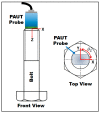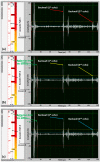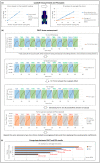Phased Array Ultrasonic Method for Robotic Preload Measurement in Offshore Wind Turbine Bolted Connections
- PMID: 38474957
- PMCID: PMC10934617
- DOI: 10.3390/s24051421
Phased Array Ultrasonic Method for Robotic Preload Measurement in Offshore Wind Turbine Bolted Connections
Abstract
This paper presents a novel approach for preload measurement of bolted connections, specifically tailored for offshore wind applications. The proposed method combines robotics, Phased Array Ultrasonic Testing (PAUT), nonlinear acoustoelasticity, and Finite Element Analysis (FEA). Acceptable defects, below a pre-defined size, are shown to have an impact on preload measurement, and therefore conducting simultaneous defect detection and preload measurement is discussed in this paper. The study demonstrates that even slight changes in the orientation of the ultrasonic transducer, the non-automated approach, can introduce a significant error of up to 140 MPa in bolt stress measurement and therefore a robotic approach is employed to achieve consistent and accurate measurements. Additionally, the study emphasises the significance of considering average preload for comparison with ultrasonic data, which is achieved through FEA simulations. The advantages of the proposed robotic PAUT method over single-element approaches are discussed, including the incorporation of nonlinearity, simultaneous defect detection and stress measurement, hardware and software adaptability, and notably, a substantial improvement in measurement accuracy. Based on the findings, the paper strongly recommends the adoption of the robotic PAUT approach for preload measurement, whilst acknowledging the required investment in hardware, software, and skilled personnel.
Keywords: non-destructive testing (NDT); offshore wind turbines (OWT); phased array ultrasonic testing (PAUT); robotics; total focusing method (TFM); ultrasonic stress measurement.
Conflict of interest statement
The authors declare no conflict of interest.
Figures















References
-
- High-Strength Structural Bolting Assemblies for Preloading—General Requirements. British-Standards-Institution; London, UK: 2015.
-
- Pressure Boundary Bolted Flange Joint Assembly. ASME; New York, NY, USA: 2022.
-
- Pan Q., Pan R., Shao C., Chang M., Xu X. Research Review of Principles and Methods for Ultrasonic Measurement of Axial Stress in Bolts. Chin. J. Mech. Eng. 2020;33:1–16. doi: 10.1186/s10033-020-0431-x. - DOI
-
- Jahani K., Langlois R.G., Afagh F.F. Structural dynamics of offshore Wind Turbines: A review. Ocean Eng. 2022;251:111136. doi: 10.1016/j.oceaneng.2022.111136. - DOI
-
- Gollub P., Jensen J.F., Giese D., Güres S. Flanged foundation connection of the Offshore Wind Farm Amrumbank West—Concept, approval, design, tests and installation. Stahlbau. 2014;83:522–528. doi: 10.1002/stab.201410178. - DOI
Grants and funding
LinkOut - more resources
Full Text Sources

